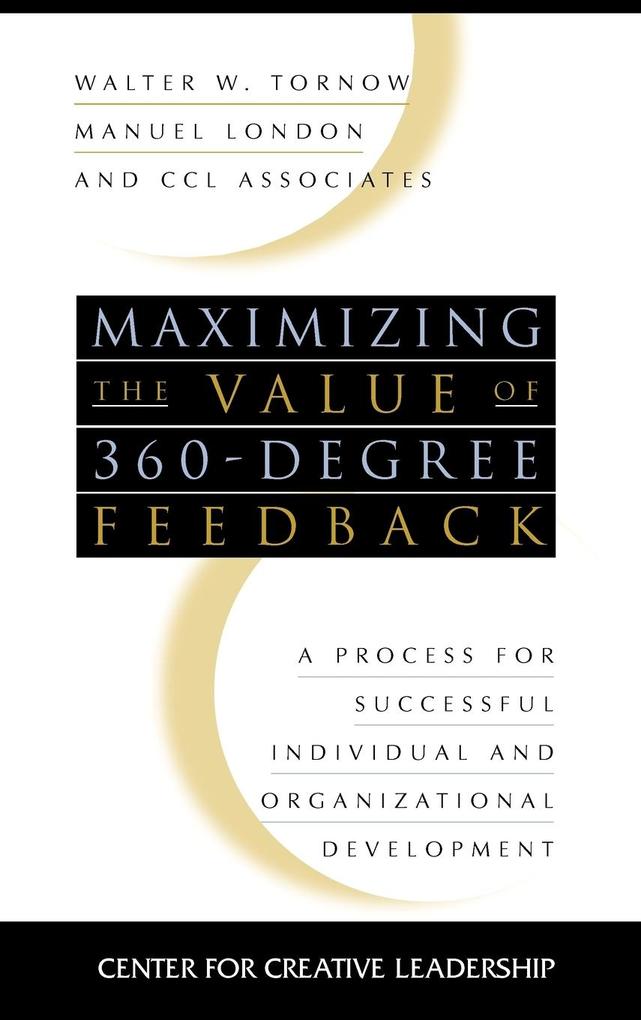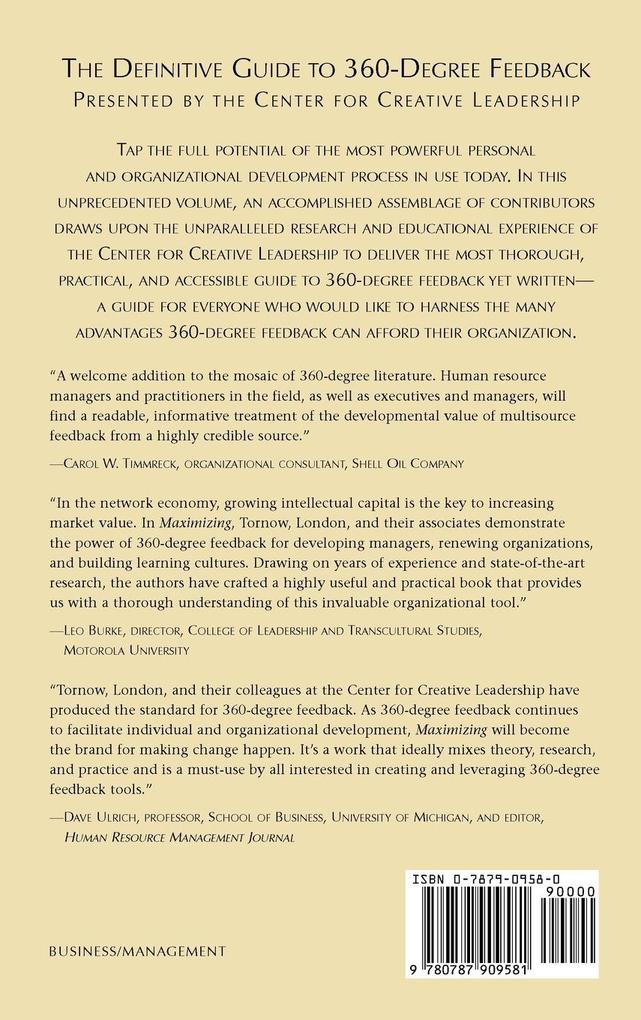
Zustellung: Do, 26.06. - Di, 01.07.
Versand in 2 Wochen
VersandkostenfreiBestellen & in Filiale abholen:
This standard-setting manual draws on the twenty-eight-year expertise the Center for Creative Leadership brings to the subject to give HR managers, consultants, and systems designers the big-picture guidance they need to determine if 360-degree feedback is right for their organization and, if so, to implement it.Readers will discover how they can use 360-degree feedback as a tool for achieving a variety of objectives such as communicating performance expectations, setting developmental goals, establishing a learning culture, and tracking the effects of organizational change. Comprehensive guidelines show how 360-degree feedback can be designed to maximize employee involvement, self-determination, and commitment. Includes case examples and a bevy of instructive instruments.
Inhaltsverzeichnis
Foreward: Goerge P. Hollenbeck.
MAXIMIZING THE VALUE OF 360-DEGREE FEEDBACK FOR INDIVIDUAL DEVELOPMENT.
Elements of Effective 360-Degree Feedback (S. Brutus, et al.).
360 in Action: Following Catharine's Footsteps Through a Leadership Development Program (W. Sternbergh).
MAXIMIZING THE VALUE OF 360-DEGREE FEEDBACK FOR ORGANIZATIONAL DEVELOPMENT.
Best Practices: Five Rationales for Using 360-Degree Feedback Process (M. Dalton).
Forces That Affect the 360-Degree Feedback Process (W. Tornow).
The Competitive Advantage of Customer Involvement in 360-Degree Feedback (C. Paradise-Tornow).
360-Degree Feedback in the Establishment of Learning Cultures (P. Wilson, et al.).
MAXIMIZING THE VALUE OF 360-DEGREE FEEDBACK THROUGH DESIGN, IMPLEMENTATION, AND MEASUREMENT.
Designing 360-Degree Feedback to Enhance Involvement, Self- Determination, and Commitment (E. Van Velsor).
Understanding Cultural Influences on the 360-Degree Feedback Process (J. Brittain Leslie & N. Gryskiewicz).
Using 360-Degree Surveys to Assess Change (J. Martineau).
Conclusion: Challenges and Implications for Maximizing 360-Degree Feedback (W. Tornow & M. London).
MAXIMIZING THE VALUE OF 360-DEGREE FEEDBACK FOR INDIVIDUAL DEVELOPMENT.
Elements of Effective 360-Degree Feedback (S. Brutus, et al.).
360 in Action: Following Catharine's Footsteps Through a Leadership Development Program (W. Sternbergh).
MAXIMIZING THE VALUE OF 360-DEGREE FEEDBACK FOR ORGANIZATIONAL DEVELOPMENT.
Best Practices: Five Rationales for Using 360-Degree Feedback Process (M. Dalton).
Forces That Affect the 360-Degree Feedback Process (W. Tornow).
The Competitive Advantage of Customer Involvement in 360-Degree Feedback (C. Paradise-Tornow).
360-Degree Feedback in the Establishment of Learning Cultures (P. Wilson, et al.).
MAXIMIZING THE VALUE OF 360-DEGREE FEEDBACK THROUGH DESIGN, IMPLEMENTATION, AND MEASUREMENT.
Designing 360-Degree Feedback to Enhance Involvement, Self- Determination, and Commitment (E. Van Velsor).
Understanding Cultural Influences on the 360-Degree Feedback Process (J. Brittain Leslie & N. Gryskiewicz).
Using 360-Degree Surveys to Assess Change (J. Martineau).
Conclusion: Challenges and Implications for Maximizing 360-Degree Feedback (W. Tornow & M. London).
Produktdetails
Erscheinungsdatum
23. März 1998
Sprache
englisch
Seitenanzahl
320
Autor/Autorin
Manuel London, Walter W Tornow
Verlag/Hersteller
Produktart
gebunden
Gewicht
674 g
Größe (L/B/H)
235/157/23 mm
ISBN
9780787909581
Bewertungen
0 Bewertungen
Es wurden noch keine Bewertungen abgegeben. Schreiben Sie die erste Bewertung zu "Maximizing the Value of 360-Degree Feedback" und helfen Sie damit anderen bei der Kaufentscheidung.










